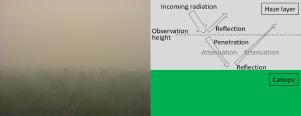Agricultural and Forest Meteorology ( IF 6.2 ) Pub Date : 2021-02-09 , DOI: 10.1016/j.agrformet.2021.108348 Shinjiro Ohkubo , Takashi Hirano , Kitso Kusin

|
Tropical peat swamp forests have been experiencing drastic disturbances, such as deforestation, drainage, and fire. We examined how such disturbances influence albedo, which regulates radiative energy exchange between the terrestrial surface and the atmosphere. We conducted continuous field observations at three sites: undrained forest (UF), drained forest (DF), and drained burned ex-forest (DB), in Central Kalimantan, Indonesia, for over 13 years.
Observed albedo was strongly influenced by haze caused by fire because the haze layer covering the canopy has a relatively high reflectance. Under severe haze conditions in October 2015, apparent albedo increased to 0.156, 0.162, and 0.183 at the UF, DF, and DB sites respectively. Mean monthly albedos excluding fire periods were 0.094 ± 0.005, 0.092 ± 0.006, and 0.099 ± 0.017 (mean ± 1 standard deviation) at the UF, DF, and DB sites respectively. Seasonal fluctuation in albedo at the DB site, where ferns were dominant, was greater than at the UF and DF sites.
Albedo at the DF site was significantly lower than that at the UF site from February to August (p < 0.05). At the forest sites the albedo increased as groundwater level decreased. Albedo was higher under high vapor pressure deficit at all sites. At the DB site albedo decreased when the soil surface was water-saturated and patched with puddles, potentially due to the low albedo of open water. The albedo at the DB site was lower than that at the forest sites at the beginning of the observation period. Subsequently, the albedo increased and exceeded those at the UF and DF sites immediately after fire damage in 2009. This could be explained by the expansion of bright-colored ferns and sedges over dark-colored peat soil. According to our results, haze, groundwater level, and vegetation cover significantly influence albedo in tropical peat swamp forests.
中文翻译:

扰动和环境变化对热带泥炭生态系统反照率的影响
热带泥炭沼泽森林一直遭受严重破坏,例如森林砍伐,排水和火灾。我们研究了这种扰动如何影响反照率,反照率调节了地面和大气之间的辐射能量交换。我们在印度尼西亚中部加里曼丹省的三个地点进行了连续的实地观测:不排水森林(UF),排水森林(DF)和排水燃烧的前森林(DB),历时13年以上。
观察到的反照率受火灾引起的霾的强烈影响,因为覆盖在树冠上的霾层具有相对较高的反射率。在2015年10月的严峻雾霾条件下,超滤,DF和DB站点的表观反照率分别增至0.156、0.162和0.183。UF,DF和DB站点的不包括火灾期的平均每月反照率分别为0.094±0.005、0.092±0.006和0.099±0.017(均值±1标准偏差)。蕨类植物占主导地位的DB站点反照率的季节性波动大于UF和DF站点的反照率。
2月至8月,DF站点的反照率显着低于UF站点的反照率(p<0.05)。在森林站点,反照率随地下水位降低而增加。在所有地点,在高蒸气压亏缺下反照率都较高。在DB处,当土壤表面被水饱和并用水坑修补时,反照率会降低,这可能是由于开放水的反照率低所致。在观测期开始时,DB站的反照率低于森林站的反照率。随后,在2009年火灾破坏后,反照率增加并超过了超滤区和测向区的反射率。这可以用深色蕨菜在深色泥炭土上的膨胀来解释。根据我们的结果,薄雾,地下水位和植被覆盖对热带泥炭沼泽森林的反照率有显着影响。



























 京公网安备 11010802027423号
京公网安备 11010802027423号